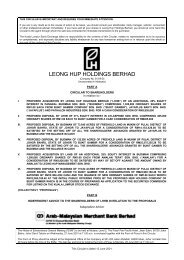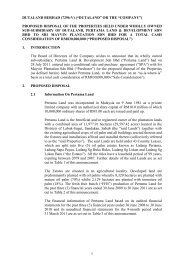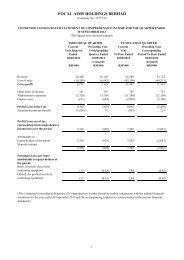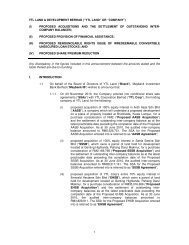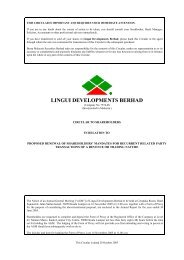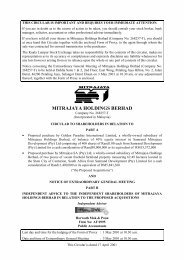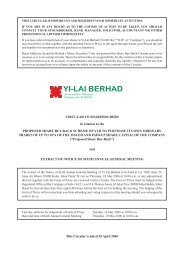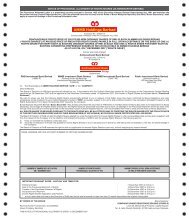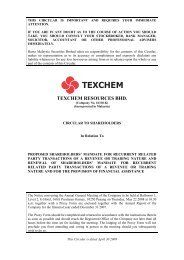Notice of Annual General Meeting - Announcements - Bursa Malaysia
Notice of Annual General Meeting - Announcements - Bursa Malaysia
Notice of Annual General Meeting - Announcements - Bursa Malaysia
You also want an ePaper? Increase the reach of your titles
YUMPU automatically turns print PDFs into web optimized ePapers that Google loves.
40<br />
ANNUAL REPORT 2012 GROMUTUAL BERHAD (Company No. 625034-X)<br />
NOTES TO THE FINANCIAL STATEMENTS<br />
FOR THE YEAR ENDED 31 DECEMBER 2012 (continue)<br />
Impairment <strong>of</strong> Tangible Assets<br />
At the end <strong>of</strong> each reporting date, the Group and the Company review the carrying amounts <strong>of</strong><br />
tangible assets to determine whether there is any indication that those assets have suffered an<br />
impairment loss. If such indication exists, the recoverable amount <strong>of</strong> asset is estimated in order to<br />
determine the extent <strong>of</strong> impairment loss (if any).<br />
Recoverable amount is the higher <strong>of</strong> fair value less costs to sell and value in use. In assessing value in use,<br />
the estimated future cash flows are discounted to their present value using a pre-tax discount rate that<br />
reflects current market assessments <strong>of</strong> the time value <strong>of</strong> money and the risks specific to the asset for<br />
which the estimates <strong>of</strong> future cash flows have not been adjusted.<br />
If the recoverable amount <strong>of</strong> an asset (or cash-generating unit) is estimated to be less than its carrying<br />
amount, the carrying amount <strong>of</strong> the asset (or cash-generating unit) is reduced to its recoverable amount.<br />
An impairment loss is recognised immediately in pr<strong>of</strong>it or loss, unless the relevant asset is carried at a<br />
revalued amount, in which case the impairment loss is treated as a revaluation decrease.<br />
Where an impairment loss subsequently reverses, the carrying amount <strong>of</strong> the asset is increased to the<br />
revised estimate <strong>of</strong> its recoverable amount, but so that the increased carrying amount does not exceed<br />
the carrying amount that would have been determined had no impairment loss been recognised for the<br />
asset in prior years. A reversal <strong>of</strong> an impairment loss is recognised immediately in pr<strong>of</strong>it or loss, unless the<br />
relevant asset is carried at a revalued amount, in which case the reversal <strong>of</strong> the impairment loss is<br />
treated as a revaluation increase.<br />
Financial Instruments<br />
Financial instruments are recognised in the statements <strong>of</strong> financial position when, and only when, the<br />
Group and the Company become a party to the contractual provisions <strong>of</strong> the financial instruments.<br />
Where the purchase or sale <strong>of</strong> a financial asset is under a contract whose terms require delivery <strong>of</strong> the<br />
financial asset within the timeframe established by the market concerned, such financial assets are<br />
recognised and derecognised on trade date.<br />
Financial instruments are initially measured at fair value, plus transaction costs, except for those financial<br />
assets classified as at fair value through pr<strong>of</strong>it or loss, which are initially measured at fair value.<br />
Financial Assets<br />
Financial assets are classified into the following specified categories: financial assets “at fair value<br />
through pr<strong>of</strong>it or loss” (“FVTPL”), “held-to-maturity” (“HTM”) investments, “available-for-sale” (“AFS”)<br />
financial assets and “loans and receivables” (“L&R”). The classification depends on the nature and<br />
purpose <strong>of</strong> the financial assets and is determined at the time <strong>of</strong> initial recognition.<br />
Effective interest method<br />
The effective interest method is a method <strong>of</strong> calculating the amortised cost <strong>of</strong> a financial asset and <strong>of</strong><br />
allocating interest income over the relevant period. The effective interest rate is the rate that exactly<br />
discounts estimated future cash receipts (including all fees on points paid or received that form an<br />
integral part <strong>of</strong> the effective interest rate, transaction costs and other premiums or discounts) through<br />
the expected life <strong>of</strong> the financial asset, or (where appropriate) a shorter period, to the net carrying<br />
amount on initial recognition.<br />
Income is recognised on an effective interest basis for debt instruments other than those financial assets<br />
classified as at FVTPL.<br />
Financial assets at fair value through pr<strong>of</strong>it or loss (“FAFVTPL”)<br />
Financial assets are classified as at FAFVTPL where the financial asset is either held for trading or it is<br />
designated as such upon initial recognition.<br />
A financial asset is classified as held for trading if:<br />
• it has been acquired principally for the purpose <strong>of</strong> selling in the near future; or<br />
• it is a part <strong>of</strong> a portfolio <strong>of</strong> identified financial instruments that the Group manages together and<br />
has a recent actual pattern <strong>of</strong> short-term pr<strong>of</strong>it-taking; or<br />
• it is a derivative that is not designated and effective as a hedging instrument.<br />
A financial asset other than a financial asset held for trading may be designated as at FVTPL upon<br />
initial recognition if:<br />
• such designation eliminates or significantly reduces a measurement or recognition inconsistency<br />
that would otherwise arise; or<br />
• the financial asset forms part <strong>of</strong> a group <strong>of</strong> financial assets or financial liabilities or both, which is<br />
managed and its performance is evaluated on a fair value basis, in accordance with the Group's<br />
documented risk management or investment strategy, and information about the grouping is provided<br />
internally on that basis; or




